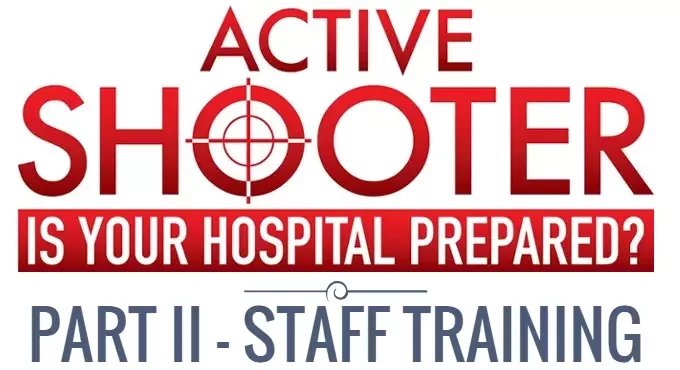
“Wounded Man Fires Gun Twice at Va. Hospital”
“Former Patient Kills Doctor in Hospital Before Committing Suicide”
“Toddler Shot by Mother’s Gun in Miss. Emergency Room”
“Employee Shot in Ariz. Hospital Parking Garage”
This is just a sampling of headlines about hospital shootings that have occurred across the United States in 2016. How many of these hospitals thought that an active shooter situation would take place on their campus? How many were adequately prepared to respond?
Structurally, hospitals are considered to be a “soft target” for an active shooter situation. They have the following characteristics which leave them vulnerable:
- Open 24 hours a day
- Large, oftentimes with multiple buildings
- Multiple entrances that may be unmanned, unlocked, and/or unmonitored for several hours a day
- Lots of hallways, rooms, and closed doors, providing more than adequate places to hide & to plan and/or target staff and others (patients/visitors)
- Often have areas under construction (Healthcare and Public Health Sector Coordinating Council, 2015)
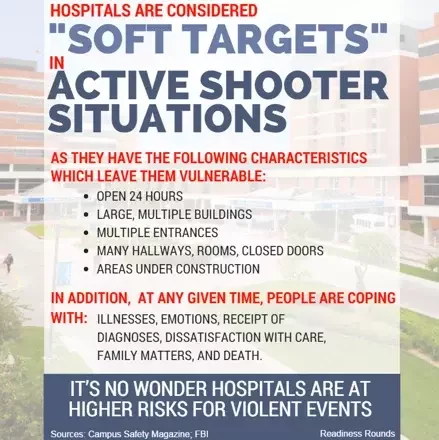
In addition, emotions tend to run high and behaviors of patients and/or visitors may be outside of their norm as they may be coping with illness (either themselves or a family member), receipt of a potentially life-threatening diagnosis, dissatisfaction with care, personal issues, family disagreements, and death – it’s no wonder hospitals are at a higher risk for a violent event to occur within its walls.
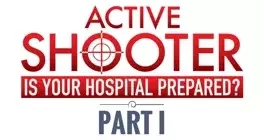
planning out staff training.
In Part I, some facts and figures were active shooter part 1 blog linkprovided regarding hospital shootings, as well as an example of a plan from the FBI Active Shooter Planning and Response in a Healthcare Setting. For Part II, I will talk about the most critical part of active shooter preparation –
It is leadership’s responsibility to ensure that every staff member is familiar with their facility's Active Shooter portion of the Emergency Management (EM) plan. Hospitals routinely have fire drills and severe weather response drills to ensure that the staff is prepared in their designated roles to protect themselves and their patients. It is equally, if not more important to have structured and coordinated drills in the event an active shooter is on campus, or gains access to your facility.
Preparation can be difficult as “no profile exists for an active shooter” FBI active shooter report link(Healthcare and Public Health Sector Coordinating Council, 2015). Staff must be provided the necessary tools to learn to be vigilant in watching for signs and unusual behaviors in patients and family members. They also need to know how to report suspicious activity or threatening actions to others, as well as how to respond in the event that an active shooter is in their area. Healthcare providers have an interesting challenge which makes proper training even more important – they have to be aware of and work through some key ethical dilemmas in their role of caregiver. Each individual must remain calm enough during the emergency situation to make appropriate decisions regarding their well-being and that of their patients.
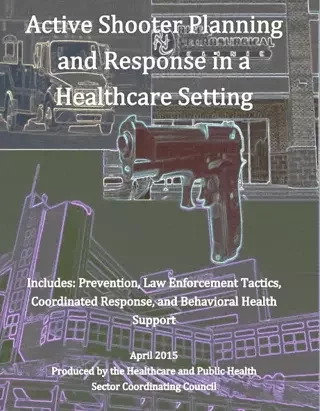
Consider inclusion of the following elements when developing your staff training plan and response drills (this list is not all inclusive):
1. Openly discuss caregivers’ roles and responsibilities:
- Learning “the signs of a potentially volatile situation and ways to prevent an incident” (Healthcare and Public Health Sector Coordinating Council, 2015)
- Staying calm when a situation arises
- Adequately assessing the situation and appropriate response
- Primary focus is always the safety of yourself, the patient, staff, and visitors
2. Emergency notification processes – always ensure your safety before notifying others:
Internal:
- Operator (will generally contact law enforcement)
- Security/Administration
- Nearby staff
- Patients/Visitors in area
- Others in area (vendors/construction crew)
Information to provide:
- Location
- Number of suspects present
- Description of shooter/s
- Weapons involved
- Shots fired
3. Actions to consider in response to threat:
- Run:active shooter | patient safety
- Evacuation route/s:
- Assembly point/s
- Process if evacuation route inaccessible
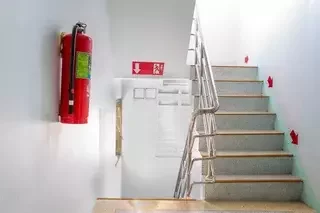
Hide:
- Shelter-in-place
- Discuss qualities of a safe place to hide (no windows/lockable doors/thicker walls)
- Barricading
- Management of patients in high-care areas that may not be able to safely evacuate
Fight:
- Always the last resort and only if confronted by shooter
- Defend yourself
- Safe techniques for subduing a shooter:
- Injuring shooter with equipment or other easily available items
- Physically apprehending and subduing shooter
4. Response processes for specialty areas:
- Radiology areas
- Surgical suites
- Psychiatric Units
5. Interacting with law enforcement (LE) once they arrive on the premises:
- LE internal processes staff may be a part of
- LE terms that staff may hear during event

6. Post-incident:
- Debriefing
- Hospital support measures:
- First Aid/Triage
- Counseling
Works Cited
Campus Safety. (2016, Sept. 4). Hospital Shootings. Retrieved from Campus Safety: http://www.campussafetymagazine.com/topic/tag/Hospital_Shootings
Healthcare and Public Health Sector Coordinating Council. (2015, April 17). Active Shooter Planning and Response in a Health Care Setting. Retrieved from FBI: https://www.fbi.gov/file-repository/active_shooter_planning_and_response_in_a_healthcare_setting_2015.pdf/view
